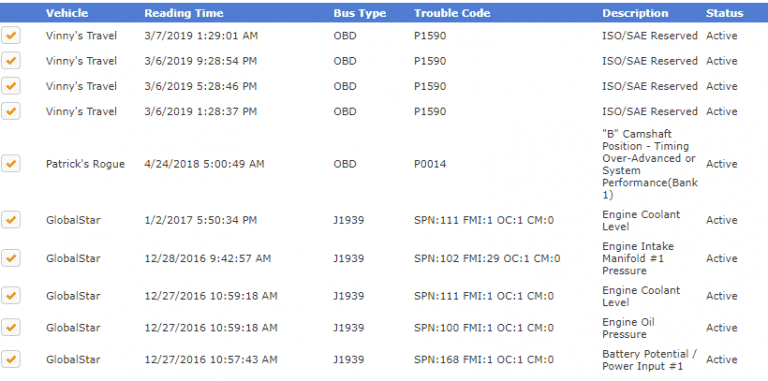Fleet managers and maintenance teams are increasingly proactive when it comes to detecting and diagnosing issues with their vehicles and equipment. In the past, operators reported issues manually when that pesky “check engine” light came on. Now, on board diagnostic tools and telematics help identify issues immediately and trigger alerts that help you initiate preventative maintenance. But as vehicles become more advanced, repairs and parts become more expensive. This makes automation and speedy maintenance all that much more important.
But how does all of this work? The answer is Diagnostic Trouble Codes, or DTCs.

What is a DTC Code?
Diagnostic Trouble Codes (DTCs) are the codes that identify specific issues with vehicles or equipment as they arise. Diagnostic trouble codes generate whenever the vehicle diagnoses an issue over several start/stop cycles of the engine, or if the issue is of significant severity.
Unlike the check engine light (or malfunction indicator lamp), DTC codes and get at the specific underlying malfunction that needs to be addressed. DTC codes are the diagnostic terminology created by the Society of Automotive Engineers (SAE) to ensure there is a uniform mechanism for reporting faults on a vehicle.
How do you get diagnostic trouble codes?
DTCs are typically generated by a vehicle’s on-board diagnostic system (OBD). The OBD is able to detect malfunctions and report them to the driver using indicators like the malfunction indicator lamp (MIL). Once the OBD detects a malfunction, maintenance technicians can use an OBD scanner, which plugs into the OBD port in the vehicle and reports back a specific code. The DTC code is then used by the mechanic to understand what’s at fault and how to fix the vehicle.
Fleets often use advanced telematics devices to assess vehicle performance and GPS location data. Many telematics gateways plug directly into the OBD port to help bypass manual diagnostic steps and automatically send alerts and the DTC codes directly to the fleet manager and maintenance manager via a central dashboard. This helps speed up issue detection, getting to the needed vehicle service faster and leading to better asset uptime.
OBD-II vs J1939 DTC Codes
Most vehicles or heavy equipment fall into one of two major sets of standards for DTCs; OBD-II or J1939. The SAE created OBD-II so that there was a standard international DTC list for all manufacturers to use. OBD-II is the most common, but there are still some manufacturer-specific codes in existence that are harder to diagnose without the help of a mechanic.
So how do you know what DTC standards your vehicle or equipment use?
- OBD-II: Used by most cars and light trucks in the United States. This standard applies to most vehicles manufactured after 1996.
- J1939: Used by most diesel engine vehicles, heavy equipment, buses and heavy-duty trucks
Vehicle manuals and online documentation from the manufacturer will help you figure out which standard your vehicle uses if you aren’t sure.
How do you interpret a DTC Code?
OBD-II Scanners and modern telematics hardware, such as IntelliShift, can read these codes in real-time when connected to an OBD port.
The codes themselves are categorized according to the two different systems. DTCs, for example, come in four variants:
- Body (B codes) – for functions related to the passenger compartment
- Chassis (C codes) – for functions outside of the passenger compartment
- Powertrain (P codes) – for functions relating to the engine, transmission, or drivetrain
- Network & Vehicle Integration (U codes) – for functions related to the vehicle computer systems
Beyond that, the code identifies if there is a generic or manufacturer-specific issue with a number. P0102, for example, indicates a powertrain issue with the Mass Airflow Sensor. B0079 is an issue with the driver seatbelt.
For heavy-duty vehicles, the J1939 has a different approach by using Suspect Parameter Numbers, but the idea is the same.
Diagnostic Trouble Codes Lists:
How Telematics Solutions Use DTC Codes
Whether your fleet asset is OBD or J1939 compliant, telematics gateways provide DTC codes the moment it verifies an issue. For the majority of cases, telematics devices pass a description of the code to prepare a mechanic for needed work, often before the driver even notices their Check Engine light is on.
IntelliShift, for example, provides general diagnostic trouble code descriptions based on these standards. Some manufacturer-specific codes may not adhere to them, resulting in a code with no description available like Vinny’s P1590 code below. In this case, a quick search online helps a mechanic find manufacturer specific codes.

IntelliShift offers this information with our Vehicle Service module, as well as an engine diagnostics alert for real-time feedback. Our alerts system allows scheduling, so you can send these alerts to different contacts depending on the time of day the error occurs.
Learn more about how IntelliShift helps with vehicle maintenance.
Matt Aspinwall is a manager of solutions engineering at IntelliShift, bringing more than 10 years of experience working in the telematics space. He aims to impart fleet management expertise to help enterprise leaders leverage business intelligence to garner total operations excellence.


